Winter varieties of onion sets for planting before winter
Most gardeners are used to growing onions in the warm season, believing that the winter method is a thankless job and requires professional skills. However, a properly selected variety, adherence to the rules of planting and care allows you to get an excellent harvest of winter onions.
The content of the article
Description of varieties of winter onion sets
Onions for winter planting are chosen very carefully, given their adaptation to the specific climatic conditions of the region.... The best option is considered to be an early maturing frost-resistant variety, which is more likely to give a high yield.
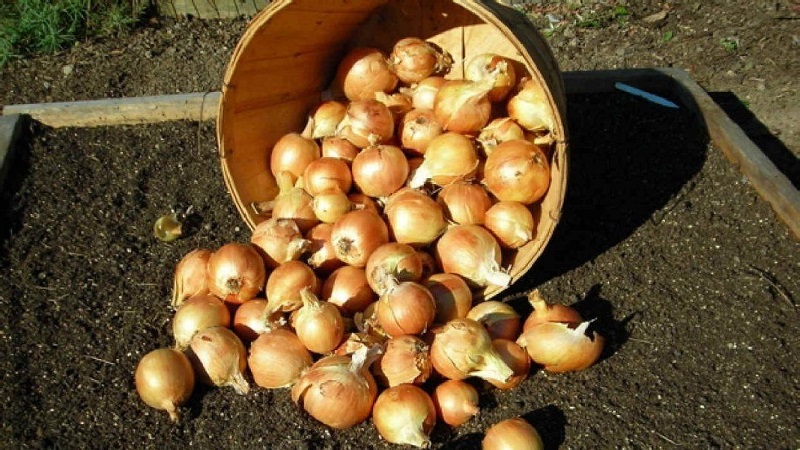
Varieties
From many varieties of onions for winter sowing gardeners mark the most prolific and useful:
- Arzamas... A mid-nesting mid-season variety with a spicy taste. It tolerates frost perfectly.
- Bamberger... German medium late variety. Elongated bulbs with a semi-sharp taste.
- Danilovsky... A high-yielding, low-breeding mid-season variety. The bulbs are flattened, reddish-purple in color, medium in size, with a spicy sweet taste.
- Radar... A popular Dutch variety with a medium ripening period. The fruits are large, semicircular, with a spicy taste.
- Red baron... Round large onions of red-purple color with a spicy sweet taste. It belongs to the early maturing variety.
- Senshui... Japanese early maturing variety. Differs in resistance to shooting, powdery mildew. The fruits are semicircular, sweet, aromatic.
- Strigunovsky... An early ripe fruitful variety of a small-nest type. Cold-resistant, but does not tolerate some diseases. The bulbs are pungent in taste and ripen early.
- Sturon... The Stuttgarter Riesen variety, improved by Dutch breeders, is resistant to shooting and various diseases. Large elliptical bulbs with a spicy taste, long shelf life.
- Timiryazevsky... Old Russian early maturing variety. Suitable for growing in northern regions. Differs in good keeping quality, high yield.
- Troy... Super early hybrid of Dutch selection, well kept, suitable for planting both in winter and in spring. The bulbs are large, with a semi-sharp taste of a round or flat-round shape.
- Ellan... The earliest, sweet winter variety. Differs in high productivity, is stored for a long time.
Orion winter bow is also gaining popularity. - an ultra-early Dutch hybrid with excellent keeping properties, and Winter onion: according to the description of the producers, it is characterized by high yield and good quality of bulbs.
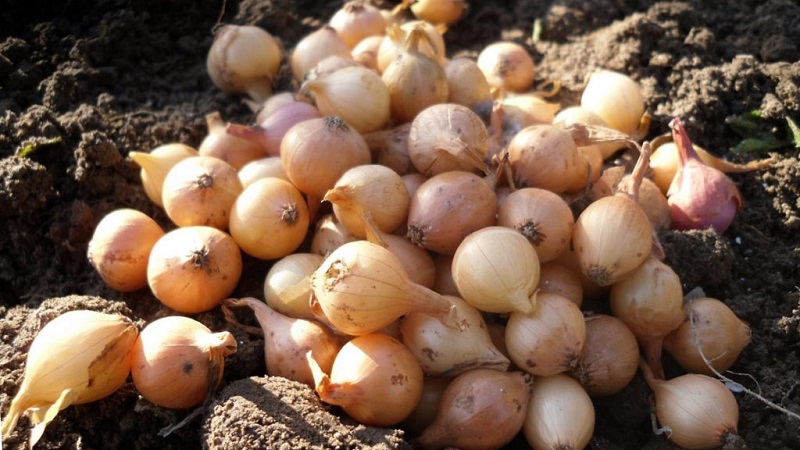
Origin and development
Many researchers find it difficult to name the period when onions began to be grown by people, but everyone agrees that this happened more than 5,000 years ago in Central Asia. The plant is mentioned in many cultures. The bow played an important role in everyday life - food preparation, medicine, art, mummification. Grew up in different regions and domesticated around the world.
Modern varieties are a plant from stem-like leaves of bluish-green color, hollow inside. The lower part of the bulb goes into the ground. A ripening vegetable accumulates nutrients first in the leaves, then, as it ripens, the onion receives them. The crop is harvested in the fall, when the upper part turns yellow, dies off.
A bulb left in the soil for the winter will form a longer, more powerful, hollow trunk in the springtopped with a spherical flower. Subsequently, the flowers give smooth triangular black seeds.
Chemical composition, trace elements, vitamins and beneficial properties
The bow collected in itself an impressive list of vitamins, including:
- retinol;
- thiamine;
- riboflavin;
- pyridoxine;
- folic acid;
- tocopherol;
- vitamin C;
- a nicotinic acid.
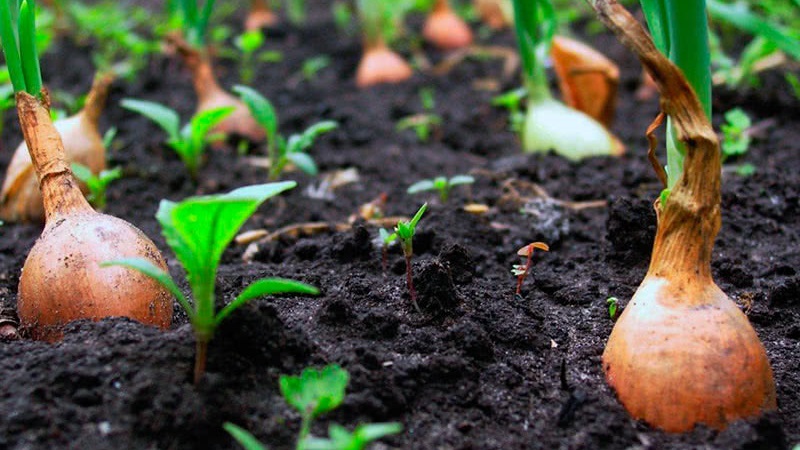
The list is also supplemented with micro and macro elements:
- calcium;
- magnesium;
- sodium;
- potassium;
- phosphorus;
- chlorine;
- sulfur;
- iron;
- zinc;
- iodine;
- copper;
- manganese;
- chromium;
- fluorine;
- boron;
- cobalt;
- aluminum;
- nickel;
- rubidium.
Onions are rich in citric, malic acids, mono- and polysaccharides, among which fructose, sucrose, maltose, glucose are found. It is used for diseases of the cardiovascular system, upper respiratory tract, intestinal atony. It is useful for hypo- and vitamin deficiencies, headaches. Helps fight furunculosis, purulent wounds, warts, freckles. Used in cosmetology to fight wrinkles, strengthen hair.
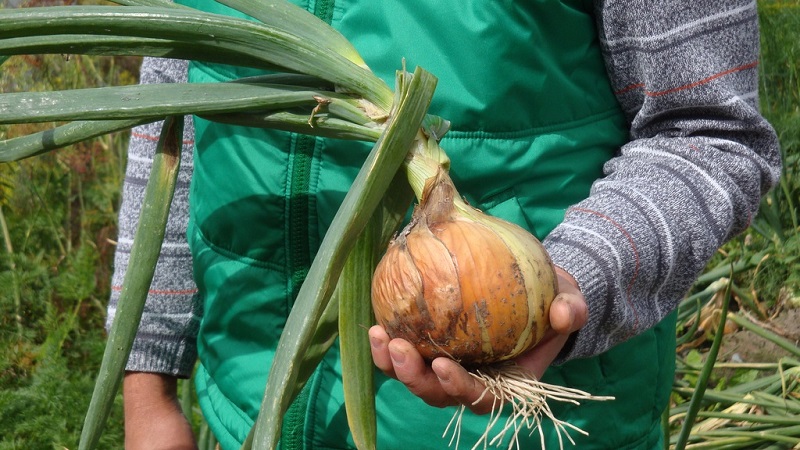
Ripening period
Onion is divided into three groups according to the ripening period.:
- early maturing (or early maturing) - the growing season is no more than 90 days;
- mid-season - growing season 100-110 days;
- late ripening - the ripening period of the bulbs is at least 120 days from the date of the appearance of green leaves.
Yield
The main reason for planting onions before winter is to get a better, more abundant harvest. 2-3 weeks ahead of schedule. The yield depends on the variety, the quality of the selected material.
Among the best varieties of winter onions, the following are distinguished by the highest productivity:
- Shakespeare - the weight of the bulb is 100 g;
- Centurion - weight 110-160 g;
- Senshui - 100 g;
- Stuttgarten Riesen - 100-150 g;
- Struton - 180 g.
Disease resistance
Thanks to the work of breeders, hybrids and varieties have been developed that easily tolerate difficult weather conditions capable of producing strong fruits in conditions of short daylight hours.
For reference. Winter onions are rarely susceptible to diseases and are resistant to pests.
Characteristics of the bulb, description of the appearance, taste
Varieties with a sharp taste are suitable for planting before winter, such are stored longer... The shape of the fruit, as well as the amount of husk, are also taken into account: the more there is, the better the onion is protected, and the longer it remains fresh. The shape can be either rounded, elongated, or rounded-flattened, flat.
For which regions is best suited, climate requirements
Onion sets are grown in all regions, including Siberiadespite the harsh conditions and low temperatures during the winter months. To preserve the harvest, the beds are mulched, sprinkled with snow.
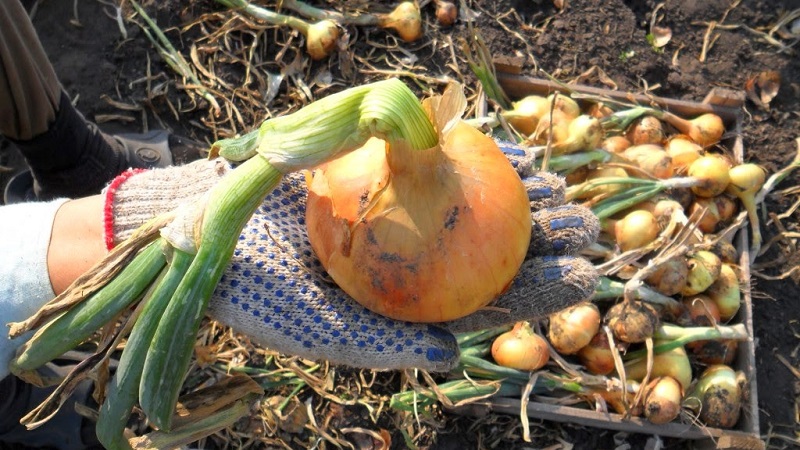
Main advantages and disadvantages
Obvious the advantages of planting winter varieties of onion sets are the following:
- Getting great onion heads from shallow seeding - the smaller the turnip, the less likely it is to shoot.
- Early harvest - winter onions ripen 6-8 weeks earlier than spring onions.
- Affordable price, large selection of planting material.
- Easy to care for. Until spring, the beds do not require watering.
- Solution of the storage issue. The resulting crop does not rot, does not start up arrows.
Of the shortcomings, they note:
- Sharp temperature changes, high humidity, severe frosts negatively affect the harvest.
- Winter varieties are stored worse than spring varieties.
Differences from other varieties
The main difference between winter types of onions is in the size of the bulbs.... The varieties planted before winter produce larger fruits with a characteristic pungent taste. Provided that the correct seed is selected, the requirements for planting and care are met, the crop is harvested already in the middle of summer.
Features of planting and growing
The main requirements in the choice of planting material are the size of the bulb and its condition... It is easier for a small onion to survive the winter in the ground. For planting, use the first grade onion or wild oat (onion sets).
Is it possible to plant before winter and how
To obtain a rich harvest, preliminary work is carried out on preparation planting site, soil, seed. For winter sowing, hybrids and varieties are chosen that are designed for an average, short daylight hours.
In places with difficult weather conditions, they seriously approach the issue of sheltering the beds. This is the only way to avoid freezing of plants.
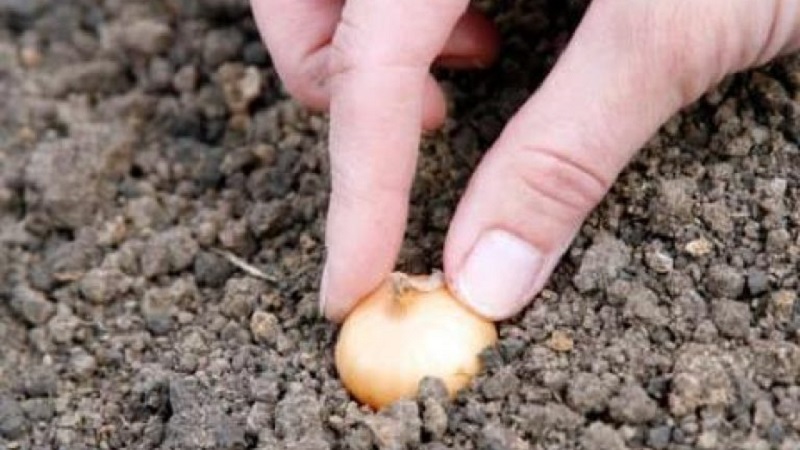
Preparing for landing
Onion preparation are practiced 2 weeks before disembarkation. They choose healthy ones, without signs of damage, with a diameter of no more than 1 cm to obtain only the head, and 1-2 cm in diameter if it is planned to also get greens. The bulbs are not soaked, the neck is not cut off.
Important! 7 days before planting, the bulbs are dipped for 10 minutes in a solution of potassium permanganate or copper sulfate, then dried thoroughly for 12-24 hours.
Ground requirements
Choose a well-lit place on a hill where moisture does not stagnate and the snow melts quickly. A bed with loose soil and neutral pH is suitable. The rules of crop rotation are observed: beets, tomatoes, rapeseed, cabbage, mustard, and cereals are considered the best predecessors.
Fertilizers are applied while digging the beds in the form of humus with the calculation of 1 bucket per square meter. Add a composition of 2 tablespoons of superphosphate, the same amount of wood ash, 1 tablespoon of urea. The acidic soil is neutralized by adding lime, chalk, superphosphates, and furnace ash.
Timing, scheme and landing rules
Be sure to comply with the landing dates... Having planted too early, they risk getting early shoots and the death of the crop from the cold. Late, they miss the moment when the onion forms the root system - without developed roots, the plants will not overwinter. The best time for sowing is November in the southern regions, September - in the northern ones.
A more accurate date depends on the climatic characteristics of a particular region.... Usually, air temperature is taken into account, forecasters forecast: if frost is promised in 14-16 days, the air temperature does not rise above 5 ° C, it's time to start landing.
Sevok is planted in rows at a distance of 40-45 cm, keeping 5-6 cm between the bulbs to a depth of 3-8 cm, depending on the size of the bulb. At the end of the beds, they are covered with straw or grass.
Note! In regions with snowy winters, the beds do not need to be covered.
Growing features
After planting, the beds are mulched before the onset of frost, so moisture is retained... With the arrival of spring, the shelter is removed so that the earth warms up better. It has been noticed that an onion planted before winter requires weeding much later, is less susceptible to diseases and pests than spring counterparts.

The nuances of care
Winter care does not involve any additional actions, except warming the beds, creating a snow layer at temperatures below 10-15 ° C. This is especially true for the northern regions.
Watering mode
Do not water the onion immediately after planting.... In dry weather, watering is carried out after 10 days. In the spring, when the snow melts, the ground contains a sufficient amount of moisture, therefore watered as neededif spring and the first month of summer are hot.
Loosening the soil and weeding
During the growth process, the soil is loosened as needed., and also a day after watering, do it carefully so as not to pull out the fruits. Weeding is carried out twice a season.
Top dressing
The first feeding is carried out after the emergence of seedlings in the spring.... For the formation of greens, a solution of 30 g of ammonium nitrate, 20 g of potassium chloride, 40 g of superphosphate, diluted in 10 liters of water, is introduced.Three weeks later, re-feeding is carried out, increasing the amount of superphosphate to 60 g, potassium - up to 30 g.
For the third time, a solution is introduced consisting of 10 l of water, 20 g of potassium, 40 g of phosphate.
Disease and pest control
Most often, the culture is exposed to the disease downy mildew.... To protect the plant from disease, in the fall, before planting in the ground, the seedlings are examined for damage by disease or insects. At the slightest sign, the fruits are treated with fungicides, following the manufacturer's instructions. They also use fermented milk products, iodized or soda solution to fight the disease.
To avoid fungal attack, monitor compliance with the rules for storing the crop, crop rotation.
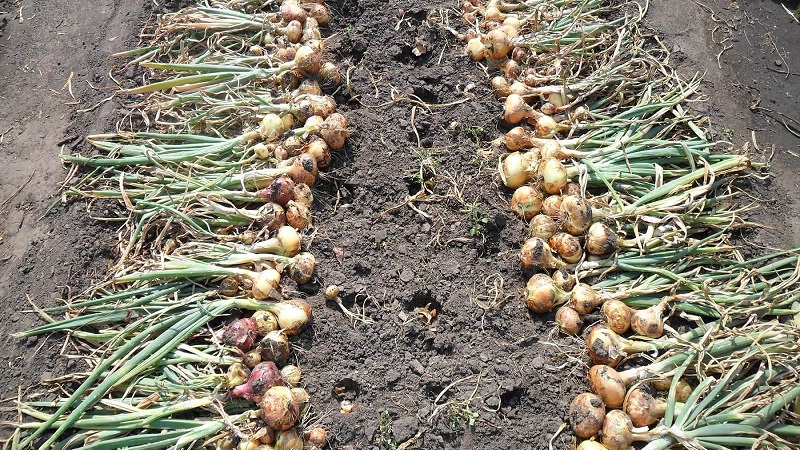
Harvesting and storage
Nets, cardboard boxes, wooden boxes with openings for air intake are suitable as storage containers.
How and when to collect
Collect the bow after the aerial part of the leaves turns yellow and dries - in late spring – early summer. Complete collection is carried out before the beginning of August, in dry, calm weather. The dug crop is left for some time in the garden to dry, leaving in the sun, spread out in a thin layer. The top feathers are removed. Then they are laid out in containers, moved to a cool room for permanent storage.
Storage features and keeping quality of the variety
If onions are stored in an apartment, the temperature should be at + 18 ... + 22 ° C, humidity - 50-70%. In basements, the optimum performance is 0 ... + 3 ° C with a humidity of 75-90%. During storage, vegetables are sorted out, rotten ones are removed, wet ones are dried.
Important! Winter onions are stored for about 6-8 months.
What can be the difficulties in growing
The main problems of farmers when growing winter onions:
- moisture retention in the bed, leading to the soaking of the bulbs;
- premature emergence of seedlings caused by early planting or deep seeding;
- poor-quality soil mulching leads to damage to the bulbs.
Tips from experienced gardeners
Several recommendations of experienced farmers:
- Onions planted close to each other break through in spring, leaving only strong, high-quality specimens with a distance of 8-10 cm.
- Several varieties are planted at once. Thus, after harvesting, the most productive crops are selected for further cultivation.
- It is better not to use the film as a cover.
- Fresh manure is not suitable for fertilizing onions.
- To prevent the onion from going into the greens, the garden is poured with boiling water before planting, and the material is dipped in a potassium permanganate solution for 10-15 minutes.
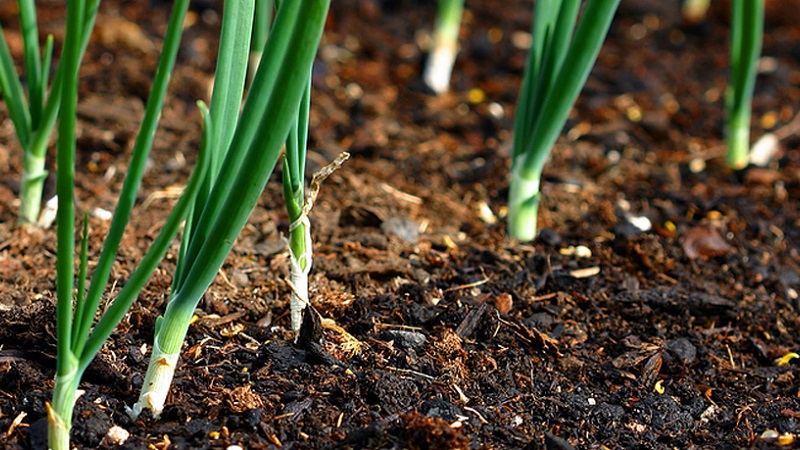
Reviews of winter varieties of onion sets
When planting onion sets before winter, choose the variety with special care.... Winter planting is becoming more and more popular with vegetable growers, and summer residents are happy to share their impressions of their favorite varieties.
Elena, Oryol region: “I plant in winter because I don’t have to worry about where and how to store onions for sowing. I planted it out before the frost, covered it with leaves from the garden, if necessary, got greens and a turnip in the spring. ".
Grigory, Rostov region: “For several years now I have been planting Radar onions - the bulbs are large and ripen early. I like to grow due to the ease of care. There is less grass in the beds, and there is almost no need to water ".
Valentina, Perm: “Despite the fact that such onions are stored worse than spring onions, the bulbs are larger and denser. Planting varieties of Senshui, Shakespeare. The bulbs are sweet, the children eat with a bang ".
Conclusion
Having prepared and planted onion sets in the garden for the winter, summer residents get a high-quality and earlier harvest. The main conditions for high yields are competent preparation of seed and the correct choice of a variety intended for growing in a particular region.